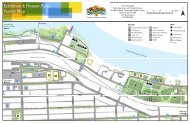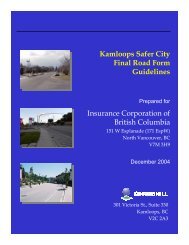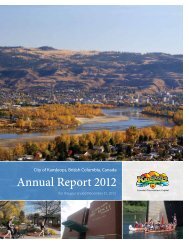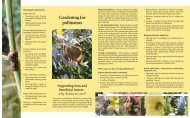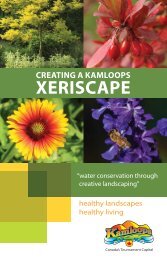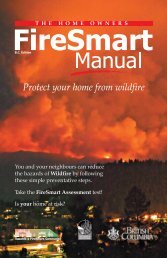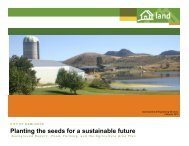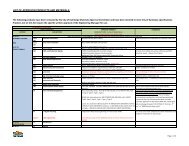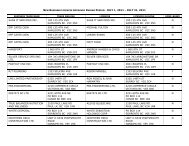GEOTOUR GUIDE - City of Kamloops
GEOTOUR GUIDE - City of Kamloops
GEOTOUR GUIDE - City of Kamloops
Create successful ePaper yourself
Turn your PDF publications into a flip-book with our unique Google optimized e-Paper software.
(sTop 15) Where does our yard Green WasTe Go?<br />
Cinnamon ridGe ComposTinG faCiliTy<br />
Figure 57. Long piles <strong>of</strong> green waste are composted at the Cinnamon<br />
Ridge Compost Facility west <strong>of</strong> the airport. Cinnamon Ridge, from<br />
which the facility takes its name, rises in the background on the<br />
north side <strong>of</strong> the Thompson River valley (see Stop 2). (Photo by<br />
R..Turner)<br />
The <strong>City</strong> <strong>of</strong> <strong>Kamloops</strong> operates the Cinnamon Ridge<br />
Compost Facility west <strong>of</strong> the airport on Tranquille Road.<br />
Residents can drop <strong>of</strong>f yard wastes such as lawn clippings,<br />
leaves and garden wastes, shrub and tree branches up to<br />
15 cm diameter, and even sod and turf. The facility grinds<br />
and mixes the greenwaste and piles it in long piles where<br />
it composts through natural bacterial activity. To maintain<br />
optimal conditions for the bacterial growth and ensure all<br />
material composts, machinery is used to add water and turn and mix the wastes. Heat produced by the bacteria as they digest<br />
the organic matter raises the temperature inside the piles to about 50 degrees Celsius – almost too hot to touch! Such high<br />
temperatures kill pathogens such as viruses. After seven or eight months <strong>of</strong> composting, the composted material is available for<br />
purchase. It is excellent addition to garden soils by providing organic matter, water retention, and nutrients. The <strong>City</strong> estimates<br />
that more than 11,000 tonnes <strong>of</strong> yard waste was diverted from the <strong>City</strong> landfill in 2005. Information on the compost facility and<br />
home composting can be found on the <strong>City</strong> <strong>of</strong> <strong>Kamloops</strong> website at www.kamloops.ca.<br />
Figure 59. A view <strong>of</strong> the Cinnamon Ridge Compost Facility<br />
from the trail on Cinnamon Ridge (Stop 2). The brown rows are<br />
composting organic yard wastes. The facility sits at the growing<br />
edge <strong>of</strong> the Thompson River delta, where the river meets <strong>Kamloops</strong><br />
Lake (see Stop 4). A separate part <strong>of</strong> the compost facility mixes<br />
green yard waste with biosolids from the waste water treatment<br />
plant to produce a composted soil for use in <strong>City</strong> parks. This<br />
material is not currently available to the public. The compost<br />
facility is part <strong>of</strong> a larger farm area where treated waste water from<br />
the treatment plant across the river is used to irrigate hay and<br />
alfalfa crops. (Photo by R..Turner)<br />
How to get to tHe Composting faCility:<br />
The <strong>City</strong> <strong>of</strong> <strong>Kamloops</strong> Cinnamon Ridge composting facility is on Tranquille Road west <strong>of</strong> the airport.<br />
33<br />
Figure 58. Green waste is<br />
loaded into a grinder at the<br />
compost facility. Grinding is<br />
essential to the composting<br />
process as it increases the<br />
surface area that bacteria can<br />
colonize and digest. (Photo by<br />
R..Turner)




